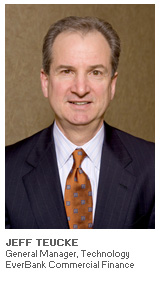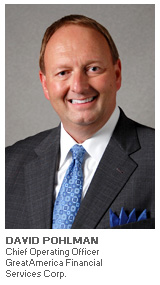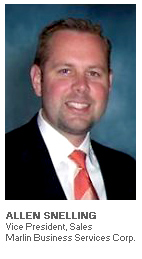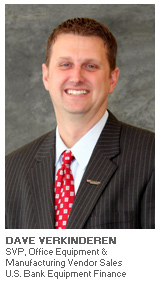As we head into the final months of 2013, Equipment Finance Advisor connects with executives from four leading IT vendor finance shops to get their take on topics ranging from what vendors and manufacturers seek from their financing partners to the impact of SaaS solutions and cloud computing on their businesses. We spoke with Jeff Teucke at EverBank Commercial Finance, David Pohlman at GreatAmerica Financial Services, Allen Snelling at Marlin Business Services and Dave Verkinderin at U.S. Bank Equipment Finance.
Each offers a unique view of the markets they serve, yet some common attributes emerge as critical to success. These professionals agree: innovation, dependability, deep sector knowledge and customized solutions are at the top of the list these days for vendors working with their financing partners.
We thank Jeff, Allen, Dave and David for taking the time to share their thoughts and their experiences.
Feel free to read these four perspectives in any order you prefer.
EverBank Commercial Finance: Flexibility Comes First
Equipment Finance Advisor: Vendor financing’s roots trace themselves to “exclusive programs” – a company typically partnered with one specific finance company. In some industries, this evolved into a “multiple funding partners” model over the years. Are equipment manufacturers, distributors, resellers etc., seeking exclusive relationships today, or do they typically utilize more than one financing source? Please explain what you are seeing in the market.
Jeff Teucke: We typically see multiple funding relationships as most funders cannot handle the full breadth of needs on the basis of transaction size, credit quality or exposure to a particular obligor. In some instances, an exclusive relationship can work if the funder has an ability to place deals that don’t fit their appetite and is willing to act in a brokerage capacity for their client.
Equipment Finance Advisor: What are vendors seeking today from a vendor finance company beyond good interest rates and superior customer service? What are the two most important features a vendor finance program must provide today to be successful?

Teucke: The first is flexibility. It is a key driver for vendors, particularly in the area of documentation and the willingness to make changes to suit a vendor’s go to market strategy. Number two would be partnership – which takes many forms including relationships at multiple levels, being attentive to special requests and meeting regularly to review results, successes, challenges and future plans.
Equipment Finance Advisor: Tell us how IT developments such as cloud computing are impacting your business – do cloud computing and SaaS for example present new opportunities for vendor finance companies, or create hurdles for the financing of equipment? Please explain.
Teucke: Cloud applications do present a challenge to finance companies seeking ways to finance the deployment of hardware and software in places other than the customer’s location. In the last 12 months, we have seen an increase in the number transactions involving host waivers in an indication of the growth in hosted applications. In addition, we have had requests from a number of vendors to provide managed services offers that include the pass-through of services. Managed services agreements are the contract vehicle that vendors will use to market their cloud based services. As most lessors have system capabilities to provide pass through of services charges, the logistics of managed services come down to elements such as variable billing, unit based metering and billing and the big one – an integrated services and equipment financing contract that is acceptable to users. The singular challenge for lessors is insuring hell and high water protections – both commercial and statutory, that when completed, is still attractive to a managed services customer.
Equipment Finance Advisor: Manufacturers and resellers have had a hard time stimulating sales in this uneasy economic and tax environment – especially for expansion (not replacement) equipment. Do manufacturers that were NOT open to offering financing in the past, now recognize that vendor financing may provide a means to stimulate sales?
Teucke: We are seeing more companies recognizing the need for and the value in financing as a sales tool. In most of these cases, the challenge is changing a cash sales culture in the sales force to one that recognizes the benefits of financing. This takes two levels of commitment: The first is C–Level support and endorsement and second is training and education on the part of the vendor financing company both initially and ongoing for new recruits. Beyond the commitment, we have found that kick-off promotions to stimulate the use of financing are critical to early adoption. Lastly, public recognition and acknowledgment of financing users in publications and at sales events can help to internalize financing and begin to change the culture from cash sales to financing.
GreatAmerica Financial Services: Shelving "Canned Programs"
Equipment Finance Advisor: Vendor financing’s roots trace themselves to “exclusive programs” – a company typically partnered with one specific finance company. In some industries, this evolved into a “multiple funding partners” model over the years. Are equipment manufacturers, distributors, resellers etc., seeking exclusive relationships today, or do they typically utilize more than one financing source? Please explain what you are seeing in the market.

David Pohlman: At one time there was more exclusivity in many national programs with one, and in some cases, two funding sources affiliated with a particular program. With the onset of the financial crisis, some of those organizations experienced hiccups and challenges with their existing sources. In order to compensate, they opened their doors to more sources to maintain a consistent access to financing. The pendulum has swung a little far in the other direction with so many funding sources in the mix that the materiality to any individual financing company is just less and less. Things will eventually swing back, but what really drove it was the financial crisis. Manufacturers and vendors now feel it’s funding dependability they are after, since they are now driven by a need to regain consistency in their sales approach and get full spectrum, consistent funding. At any rate, it really did open some doors for us. There’s no doubt today that the level of exclusivity is pretty low compared to what it once was.
Equipment Finance Advisor: What are vendors seeking today from a vendor finance company – beyond good interest rates and superior customer service? What are the two most important features a vendor finance program must provide today to be successful?
Pohlman: Innovation and elements of differentiation are what come to mind -- and you could argue they are one in the same. More and more, if you’re a manufacturer and your product is fairly similar to others, you contemplate ways you can use financing to help differentiate yourself. Through innovation and flexibility on the financing side, a vendor can offer something that the marketplace or their distribution channel views as markedly better.
Another thing they are more mindful of today is the ethics and integrity of their partners, making sure their customers are treated the way they would treat them. They recognize that when they choose a financing partner, they are going to be associated with the experience that partner delivers.
Equipment Finance Advisor: Please tell how your “go to market” strategy has changed compared to say five years ago? Perhaps give us one example of what your business development team is doing today that they did not do in 2008.
Pohlman: We have fewer what I call “canned programs” these days and now use a more consultative sales approach. We go in with a blank pad, asking questions, listening, learning and ultimately creating something that is based on that organization’s specific needs. It could be made up of things we do every day, but it often becomes a customized solution that is truly unique and serves their needs. This approach serves us better and ensures that our salespeople become more skilled at their jobs as well. Once you put a program like that in place, you can look at yourself in the mirror and understand why that organization is going to do business with you instead of one of your competitors.
Equipment Finance Advisor: Tell us how IT developments such as cloud computing are impacting your business – do cloud computing and SaaS for example present new opportunities for vendor finance companies, or create hurdles for the financing of equipment? Please explain.
Pohlman: It’s a little bit of both. Certainly on the downside, there are probably fewer things that you traditionally think of as on-premise software solutions. With software, when it’s truly a SaaS model, there are financing companies that will sometimes attempt to monetize the stream of payments and so forth. If, however, there’s a disruption around that service, you’re probably not going to find a court that will force anyone to honor that arrangement. You have to be cautious in this world and clearly understand the spectrum of risk involved to be successful. On the hardware side, opportunities certainly exist. You have to be comfortable with hardware at a data center as opposed to a traditional on-premise location.
It’s also very impactful when a software company is forced to move from the traditional selling of licenses to a monthly subscription (SaaS) approach. SaaS doesn’t give them the big upfront sale, but in the very long term it probably removes some lumpiness from their financial picture. Eventually, once they have absorbed the near term financial challenge, their recurring revenue model becomes pretty consistent. Getting to this point is tough so we’ve developed some unique concepts that help mitigate the pain associated with this transition.
Equipment Finance Advisor: What do you consider to be the biggest challenges to succeed in the vendor finance market today?
Pohlman: The pace of change is rapid as things evolve and new innovations come out in the tech space. Today, in a short timeframe, you have to be able to identify the risk points, identify how to mitigate those risks, and see if an opportunity exists in the end. Those with the ability and depth of knowledge to properly discern these elements are going to find an opportunity-rich environment. Those who struggle in that area are probably going to find this space extremely challenging.
Equipment Finance Advisor: Manufacturers and resellers have had a hard time stimulating sales in this uneasy economic and tax environment – especially for expansion (not replacement) equipment. Do manufacturers that were not open to offering financing in the past, now recognize that vendor financing may provide a means to stimulate sales?
Pohlman: I think more vendors and manufacturers are open to offering financing solutions than they once were. I sometimes hear people say, “Well, all of our customers pay cash.” But what about the ones who didn’t buy? I think in reality all of their customers who bought paid cash because that was the only option they were presented. More manufacturers and vendors are clearer today about the benefit of integrating a finance option into their sales process. Many have come to realize these are just options and that you will never offend a customer by giving them an alternate way to buy. In any economy, it just seems foolish not to present all buying options to a customer.
Equipment Finance Advisor: Do you anticipate hiring more business development professionals in 2014?
Pohlman: We’ve continued to add business development professionals each and every year of our 20-year existence. Going forward, we’ll continue to grow and add at a pace that is manageable and where we can do it and do it well.
Marlin Business Services: Providing Transparency Every Step of the Way
Equipment Finance Advisor: Vendor financing’s roots trace themselves to “exclusive programs” – a company typically partnered with one specific finance company. In some industries, this evolved into a “multiple funding partners” model over the years. Are equipment manufacturers, distributors, resellers etc., seeking exclusive relationships today, or do they typically utilize more than one financing source? Please explain what you are seeing in the market.

Allen Snelling: Whether equipment manufacturers, distributors and resellers use exclusive vendor finance providers or multiple funding partners is driven by the specific industry. For example, in food service there’s a propensity for programs to be exclusive because there are certain financial institutions that specialize in that vertical. In other verticals, I see more non-exclusive programs with vendors and manufacturers more willing to look at multiple partners. There are a couple of reasons for this. For one, they use it to protect themselves from unique events such as financial turmoil, so they have more than one funding option.
The other reason is vendors and manufacturers are realizing that if they have a wide variety of ticket sizes, they need to give people what they want. In the end everybody wants to be exclusive--they want to be the one-stop shop. In actuality very few can service all the equipment financing needs of a business with the same level of service.
Equipment Finance Advisor: What are vendors seeking today from a vendor finance company – beyond good interest rates and superior customer service? What are the two most important features a vendor finance program must provide today to be successful?
Snelling: I think the first thing manufacturers and vendors are seeking from a finance company is creativity and the energy that goes into helping them to differentiate their product through financing. Transparency is also important, all the way from their distributors to their end-users. Vendors today understand the importance of going with an integrity-driven product that’s transparent to their distributors, dealers and end-users.
Another thing that’s at the top of the list is the stability of your financing partner. Vendors and manufacturers are asking themselves “Does our financing partner have access to their own funding and access to capital to be in this relationship on a long term basis?”
Equipment Finance Advisor: Please tell how your “go to market” strategy has changed compared to say five years ago? Perhaps tell us one example of what your business development team is doing today that they did not do in 2008.
Snelling: Technology plays a part in how Marlin’s “go to market’ strategy has evolved from five years ago. For example, social media enables us to reach customers and spread the word about our vendor finance program. We are able to communicate in a more organized fashion and in a way that people are used to receiving information today. More specifically, we build online tools for our national account customers and this adds a great amount of convenience for everyone involved in the program. All the financing documents and content are stored in one place, adding efficiency for large accounts with sales professionals located across the United States. That’s proven to be more efficient and at the same time, a differentiator for us.
Equipment Finance Advisor: Tell us how IT developments such as cloud computing are impacting your business – do cloud computing and SaaS for example present new opportunities for vendor finance companies, or create hurdles for the financing of equipment? Please explain.
Snelling: I view IT developments like cloud computing as an opportunity. More and more, the market is offering SaaS solutions and vendor finance companies need to adapt. If we don’t adapt, we will see a drop off in the amount of financing that we do in the technology sector. On the other hand, there are many new entrants in the cloud. From a credit standpoint, the hurdles might be the concentrated risk aspect of building a portfolio with a cloud-based company. You have to do your due diligence on partnering with a new manufacturer’s SaaS provider so you can feel strongly that they are going to be around because there is that concentration of portfolio risk. But I do see it as tremendous opportunity and as long as it is essential-use software, we need to find a way as an industry to finance it.
Equipment Finance Advisor: What do you consider to be the biggest challenges to succeed in the vendor finance market today?
Snelling: One of the biggest challenges to succeed in the vendor finance market is having a large customer, such as a manufacturer, use the financing option as part of their growth strategy. With the end-users, you’re still going to battle their tendency to use cash. That has been the biggest challenge for Marlin in converting manufacturers. How do we make it clear enough to manufacturers, dealers and distributors so that they utilize financing strategically? We’re working hard on refining that and we’re making headway.
Equipment Finance Advisor: Manufacturers and resellers have had a hard time stimulating sales in this uneasy economic and tax environment – especially for expansion (not replacement) equipment. Do manufacturers that were not open to offering financing in the past, now recognize that vendor financing may provide a means to stimulate sales?
Snelling: The short answer is yes and I think that our customers are more inclined to invest more in understanding the benefits of financing. In the past, I don’t think that there was a willingness among manufacturers and resellers to subsidize and put the product at zero-percent on what it would cost. They didn’t see that because of the margins and so forth. One development is that they now have peers that have gone in that direction. In other words, they jumped into the fray because their competitors did.
Equipment Finance Advisor: Do you anticipate hiring more business development professionals in 2014?
Snelling: Yes, we’re planning on hiring new business development professionals next year. Marlin has grown substantially over the past three years and one of the reasons for that is because of our willingness to put resources to our partners’ programs. And we’re willing to do that in a way that we can interact with their dealers, distributors and end-user customers on a regional basis that adds real value for everyone.
U.S. Bank Equipment Finance: Keeping Up With the Speed of Change
Equipment Finance Advisor: Vendor financing’s roots trace themselves to “exclusive programs” – a company typically partnered with one specific finance company. In some industries, this evolved into a “multiple funding partners” model over the years. Are equipment manufacturers, distributors, resellers etc., seeking exclusive relationships today, or do they typically utilize more than one financing source? Please explain what you are seeing in the market.

Dave Verkinderen: We see very few exclusive programs in today’s environment. This is a big change from where we were 5-10 years ago. We typically see a minimum of two finance partners and it is not uncommon to have several lease finance partners within a program. The manufacturers in particular have taken on this multiple source strategy. Many of the independent resellers and distributors still have one primary partner in addition to one or two sources in a secondary position.
Equipment Finance Advisor: What are vendors seeking today from a vendor finance company – beyond good interest rates and superior customer service? What are the two most important features a vendor finance program must provide today to be successful?
Verkinderen: Our vendor partners have indicated they want a finance partner who understands their specific industry and can number one, help them gain a competitive advantage and number two, increase profitability. They are also looking for someone who can streamline the overall financing process by limiting their administrative expense as well as reducing their overall business risk.
Equipment Finance Advisor: Please tell how your “go to market” strategy has changed compared to say five years ago? Perhaps give us one example of what your business development team is doing today that they did not do in 2008.
Verkinderen: The biggest change is that we are now one of multiple finance sources within each program. This can be challenging at times but in many cases this has created a better solution for our vendor partners and a more competitive product for their end users. In the past finance companies spent a large amount of their time trying to become that exclusive vendor partner. The biggest difference for our business development team is the need to demonstrate your value proposition on a daily basis. We spend much more time benchmarking key financial indicators within the relationship. Additionally, we are constantly enhancing and collaborating with clients to make sure our systems work together in the most efficient way possible, automating the entire solution. It has become much more than just financing individual deals.
Equipment Finance Advisor: Tell us how IT developments such as cloud computing are impacting your business – do cloud computing and SaaS for example present new opportunities for vendor finance companies, or create hurdles for the financing of equipment? Please explain.
Verkinderen: We believe they will create more opportunities over time. Right now, finance companies have to make decisions about what can and can’t be financed within a particular transaction. Service and software are becoming a much bigger part of the solution and how we help our vendor partners manage their cash flow is a big part of this equation. You also have to think about many different solution providers and doing business with multiple solution providers within one transaction.
Equipment Finance Advisor: What do you consider to be the biggest challenges to succeed in the vendor finance market today?
Verkinderen: We believe the vendor finance market is as strong as it has ever been -- it is also extremely competitive. Historically finance companies have come in and out of this space and we expect that trend to continue. The regulatory environment will more than likely not get any easier and our clients require a very diverse set of solutions. Ultimately, we continue to believe that a solid, well rounded business model based on a long term perspective will be the most important part of future success with our vendor partners. The solution that is needed today is much more sophisticated than just a few years ago and having the experience, knowledge and resources to keep up with the speed of change will be critical.
Equipment Finance Advisor: Manufacturers and resellers have had a hard time stimulating sales in this uneasy economic and tax environment – especially for expansion (not replacement) equipment. Do manufacturers that were NOT open to offering financing in the past, now recognize that vendor financing may provide a means to stimulate sales?
Verkinderen: We have experienced this on a limited basis. Historically, we have done business in markets where financing has made up a big part of the manufacturers’ overall solution for their end users. What we have seen is more diversity on the type of strategy a manufacturer might take within their finance program.
Equipment Finance Advisor: Do you anticipate hiring more business development professionals in 2014?
Verkinderen: We are well positioned and will selectively hire business development professionals as we see growth opportunities in 2014.